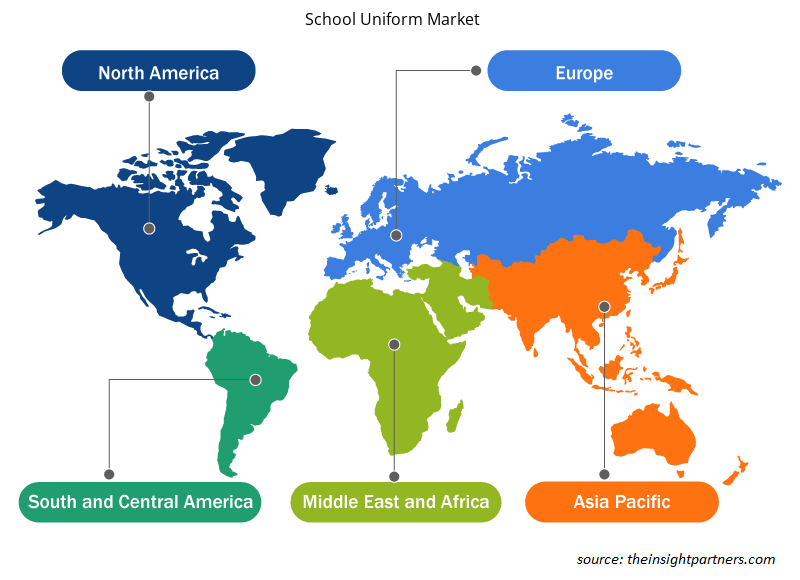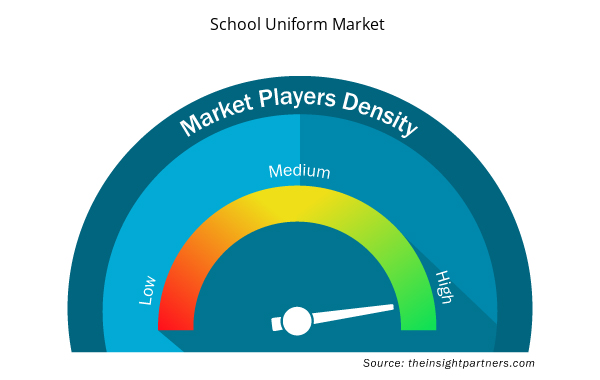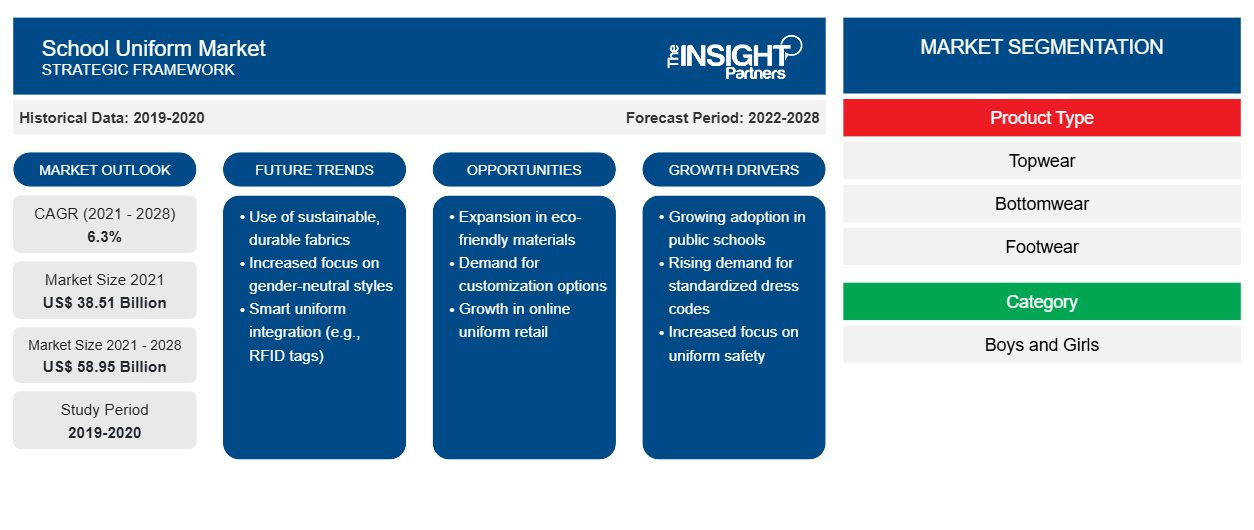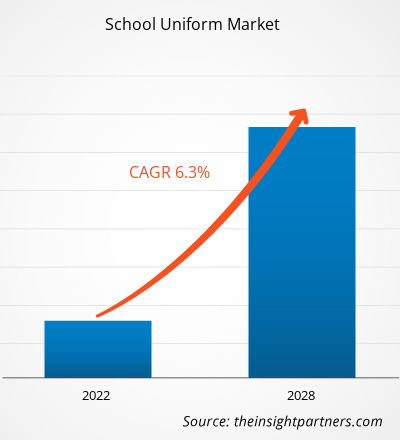[Forschungsbericht] Der Markt für Schuluniformen hatte im Jahr 2021 einen Wert von 38.505,66 Millionen US-Dollar und soll bis 2028 einen Wert von 58.950,69 Millionen US-Dollar erreichen; von 2021 bis 2028 wird ein durchschnittliches jährliches Wachstum von 6,3 % erwartet.
Schuluniformen sind eine der wichtigsten Kategorien der Kinderbekleidungsindustrie. Schuluniformen tragen positiv zum Verhalten eines Kindes in der Schule bei und fördern zudem die Lernbereitschaft. Der globale Markt für Schuluniformen ist nach Produkttyp, Kategorie, Vertriebskanal und Geografie segmentiert.
Im Jahr 2020 hatte der asiatisch-pazifische Raum den größten Anteil am weltweiten Marktanteil von Schuluniformen. Der Markt für Schuluniformen im asiatisch-pazifischen Raum ist in Australien, China, Indien, Indonesien, Südkorea und den Rest des asiatisch-pazifischen Raums unterteilt. Im asiatisch-pazifischen Raum steigt die Nachfrage nach Schuluniformen mit der wachsenden Bevölkerung, dem hohen verfügbaren Einkommen und der staatlichen Unterstützung in Ländern wie Pakistan, Indien und Bangladesch. Der Anstieg der Zahl der Bildungseinrichtungen dürfte das Marktwachstum im Prognosezeitraum weiter ankurbeln.
Passen Sie diesen Bericht Ihren Anforderungen an
Sie erhalten kostenlos individuelle Anpassungen an jedem Bericht, einschließlich Teilen dieses Berichts oder einer Analyse auf Länderebene, eines Excel-Datenpakets sowie tolle Angebote und Rabatte für Start-ups und Universitäten.
- Holen Sie sich die wichtigsten Markttrends aus diesem Bericht.Dieses KOSTENLOSE Beispiel umfasst eine Datenanalyse von Markttrends bis hin zu Schätzungen und Prognosen.
Auswirkungen der COVID-19-Pandemie auf das Wachstum des Schuluniformmarktes
Die COVID-19-Pandemie hat den Status des Konsumgütersektors drastisch verändert und das Wachstum des Schuluniformmarktes beeinträchtigt. Die Umsetzung von Maßnahmen zur Eindämmung der Ausbreitung des Virus hat die Situation verschärft. Die anhaltende Schließung von Schulen aufgrund der Pandemie hat zu beispiellosen Störungen auf dem globalen Schuluniformmarkt geführt. Da die Schulen seit fast zwei Jahren größtenteils geschlossen bleiben, waren Uniformverkäufer und -hersteller am stärksten betroffen. Viele Uniformverkäufer und -hersteller waren mit schweren Liquiditätsengpässen konfrontiert. Die COVID-19-Pandemie hat auch die Produktion von Schuluniformstoffen beeinträchtigt. Darüber hinaus hat der Online-Unterricht, der zur neuen Normalität wurde, die Nachfrage nach Schuluniformen beeinflusst. Da die Länder jedoch auf die Wiedereröffnung der Schulen hinarbeiten, wird erwartet, dass die Nachfrage nach Schuluniformen weltweit steigen wird.
Markteinblicke
Verschiedene Regierungsinitiativen zur Verbesserung des Bildungssektors
Mehrere Regierungen ergreifen Initiativen zur Verbesserung des Bildungssektors. Im Juni 2020 kündigte der britische Premierminister ein transformatives 10-Jahres-Schulumbauprogramm an, das mit über 1,3 Milliarden US-Dollar gefördert wird. Als Teil des Plans des Premierministers, die Chancen für alle zu verbessern, werden die Investitionen auf Schulgebäude in ganz England ausgerichtet, die sich in einem schlechten Zustand befinden. Darüber hinaus hat China erhebliche Investitionen in die Verbesserung des Bildungssektors und in den Ausbau des Zugangs zur Bildung für die breite Öffentlichkeit getätigt. Um sicherzustellen, dass Menschen in abgelegenen Gebieten oder Familien mit finanziellen Schwierigkeiten Zugang zu Bildungseinrichtungen haben, hat das Land besondere Aufmerksamkeit gewidmet. Daher treibt eine Zunahme verschiedener Regierungsinitiativen zur Verbesserung des Bildungssektors den Markt für Schuluniformen an.
Regionale Einblicke in den Schuluniformmarkt
Die regionalen Trends und Faktoren, die den Schuluniformmarkt im Prognosezeitraum beeinflussen, wurden von den Analysten von Insight Partners ausführlich erläutert. In diesem Abschnitt werden auch die Marktsegmente und die Geografie des Schuluniformmarkts in Nordamerika, Europa, im asiatisch-pazifischen Raum, im Nahen Osten und Afrika sowie in Süd- und Mittelamerika erörtert.

- Holen Sie sich regionale Daten zum Schuluniformmarkt
Umfang des Marktberichts für Schuluniformen
| Berichtsattribut | Details |
|---|---|
| Marktgröße im Jahr 2021 | 38,51 Milliarden US-Dollar |
| Marktgröße bis 2028 | 58,95 Milliarden US-Dollar |
| Globale CAGR (2021 - 2028) | 6,3 % |
| Historische Daten | 2019-2020 |
| Prognosezeitraum | 2022–2028 |
| Abgedeckte Segmente | Nach Produkttyp
|
| Abgedeckte Regionen und Länder | Nordamerika
|
| Marktführer und wichtige Unternehmensprofile |
|
Dichte der Marktteilnehmer für Schuluniformen: Die Auswirkungen auf die Geschäftsdynamik verstehen
Der Markt für Schuluniformen wächst rasant, angetrieben durch die steigende Nachfrage der Endverbraucher aufgrund von Faktoren wie sich entwickelnden Verbraucherpräferenzen, technologischen Fortschritten und einem größeren Bewusstsein für die Vorteile des Produkts. Mit steigender Nachfrage erweitern Unternehmen ihr Angebot, entwickeln Innovationen, um die Bedürfnisse der Verbraucher zu erfüllen, und nutzen neue Trends, was das Marktwachstum weiter ankurbelt.
Die Marktteilnehmerdichte bezieht sich auf die Verteilung der Firmen oder Unternehmen, die in einem bestimmten Markt oder einer bestimmten Branche tätig sind. Sie gibt an, wie viele Wettbewerber (Marktteilnehmer) in einem bestimmten Marktraum im Verhältnis zu seiner Größe oder seinem gesamten Marktwert präsent sind.
Die wichtigsten auf dem Markt für Schuluniformen tätigen Unternehmen sind:
- Französischer Toast
- Unternehmen: Elder Manufacturing Company, Inc.
- Winterbottoms Schulkleidung
- Williamson-Dickie Fertigungsunternehmen
- Trutex GmbH
Haftungsausschluss : Die oben aufgeführten Unternehmen sind nicht in einer bestimmten Reihenfolge aufgeführt.

- Überblick über die wichtigsten Akteure auf dem Markt für Schuluniformen
Kategorie-Einblicke
Der globale Markt für Schuluniformen ist nach Kategorien in Jungen und Mädchen unterteilt. Das Segment Mädchen hatte 2020 einen größeren Anteil am globalen Markt für Schuluniformen. Schuluniformen für Mädchen umfassen Produkte wie Poloshirts, Blusen, Hosen, Shorts, Pullover und Kleider, Röcke und Skorts, Pullover, Hoodies und Fleece, Oberbekleidung und Blazer. Das Poloshirt, eine der klassischen Oberbekleidungen, die zu den meisten Schuluniformen passt, ist in einer Reihe von Materialien und Strickarten erhältlich. Andere Accessoires wie Gürtel , Krawatten und Haarschmuck können ebenfalls Teil von Schuluniformen für Mädchen sein.
Zu den wichtigsten Akteuren auf dem globalen Markt für Schuluniformen gehören French Toast, Elder Manufacturing Company, Inc., Winterbottom's Schoolwear, Williamson-Dickie Manufacturing Company, Trutex Limited, John Lewis plc, The Uniform Company, Fraylich School Uniforms, Flash Uniforms und Alinta. Die Akteure auf dem Markt konzentrieren sich stark auf die Entwicklung qualitativ hochwertiger und innovativer Produktangebote, um die Anforderungen der Kunden zu erfüllen.
Bericht-Spotlights
- Fortschrittliche Trends auf dem Schuluniformmarkt helfen den Akteuren bei der Entwicklung wirksamer Langzeitstrategien
- In Industrie- und Entwicklungsländern angewandte Strategien für Unternehmenswachstum
- Quantitative Analyse des Schuluniformmarktes von 2019 bis 2028
- Schätzung der globalen Marktgröße für Schuluniformen
- Aktuelle Entwicklungen zum Verständnis des Wettbewerbsmarktszenarios
- Trends und Aussichten auf dem Schuluniformmarkt sowie Faktoren, die das Wachstum des Schuluniformmarktes vorantreiben und bremsen
- Unterstützung im Entscheidungsprozess durch Aufzeigen von Marktstrategien, die das kommerzielle Interesse untermauern und zum Marktwachstum führen
- Die Größe des Schuluniformmarktes an verschiedenen Knotenpunkten
- Detaillierte Übersicht und Segmentierung des Marktes sowie der Dynamik der Schuluniformbranche
- Marktgröße für Schuluniformen in verschiedenen Regionen mit vielversprechenden Wachstumschancen
Globaler Markt für Schuluniformen
Nach Produkttyp
- Oberbekleidung
- Unterbekleidung
- Fußbekleidung
- Sonstiges
Nach Kategorie
- Jungs
- Mädchen
Nach Vertriebskanal
- Supermärkte und Hypermärkte
- Fachgeschäfte
- Online-Einzelhandel
- Sonstiges
Firmenprofile
- Französischer Toast
- Unternehmen: Elder Manufacturing Company, Inc.
- Winterbottoms Schulkleidung
- Williamson-Dickie Fertigungsunternehmen
- Trutex GmbH
- John Lewis plc
- Die Uniform Company
- Fraylich Schuluniformen
- Flash-Uniformen
- Alinta
- Historische Analyse (2 Jahre), Basisjahr, Prognose (7 Jahre) mit CAGR
- PEST- und SWOT-Analyse
- Marktgröße Wert/Volumen – Global, Regional, Land
- Branche und Wettbewerbsumfeld
- Excel-Datensatz



Report Coverage
Revenue forecast, Company Analysis, Industry landscape, Growth factors, and Trends

Segment Covered
This text is related
to segments covered.

Regional Scope
North America, Europe, Asia Pacific, Middle East & Africa, South & Central America

Country Scope
This text is related
to country scope.
Häufig gestellte Fragen
Based on product type, the topwear segment led the global school uniform market in 2020. The topwear segment of school uniforms mainly includes shirts, polo shirts, blouses, blazers, sweaters, and cardigans. Shirts and blouses are available in different colors, prices, and size ranges. Shirts for school uniforms are available with long and short sleeves. For a few schools, uniforms also include apparel necessary for cold weather, such as hoodies or sweatshirts, sweaters, cardigans, and jackets. In jackets, sweaters, etc., wool is commonly used in combination with other fabrics such as polyester as it is naturally warm, thick, and soft.
Emphasis on sports and extracurricular activities in schools is the key trend for the global school uniform market. Regular physical activities benefit the reduced risk of obesity, which is otherwise a common problem among today’s kids. Sports activities also help reduce chronic muscular tension and blood sugar levels, strengthen lungs, and regulate blood pressure. Students who participate in sports grow up as more energetic individuals. Including physical activities right from childhood will help children make it a part of their routine with ease. Therefore, there is a growing emphasis on sports and extracurricular activities in schools. This, in turn, is creating demand for school sports uniforms such as t-shirts, shorts, sports jerseys, sports jackets, sports lowers, and sports shoes.
The major players operating in the global school uniform market are French Toast; Elder Manufacturing Company, Inc.; Winterbottom's Schoolwear; Williamson-Dickie Manufacturing Company; Trutex Limited; John Lewis plc; The Uniform Company; Fraylich School Uniforms; Flash Uniforms; and Alinta.
Growth in children population and low infant mortality rate are some of the key drivers for the growth of the global school uniform market. Many countries across the globe are experiencing a significant reduction in infant deaths. The reduction in infant deaths can be attributed to factors such as an increase in medical services available to the people. There has been a rise in medical professionals in many countries. Improving female education and nutrition, and increasing use of healthcare services during pregnancy and delivery, has resulted in lower child mortality. Countries such as Japan, Iceland, Singapore, and Finland have low infant mortality rates. Thus, the growth in the children population and low infant mortality rate results in an increase in the school-going population. This, in turn, is expected to aid the demand for school uniforms.
Based on category, the girls segment led the global school uniform market in 2020. School uniform for girls includes products such as polo shirts, blouses, pants, shorts, jumpers and dresses, skirts and skorts, sweaters, hoodies and fleece, outwear and blazers. Other accessories such as belts, ties, and hair accessories can also be a part of girls’ school uniforms.
During the forecast period, Asia-Pacific is anticipated to account for the largest share of the global school uniform market. Asia-Pacific region comprises several developed and developing economies, including China, India, Japan, South Korea, among others. In Asia-Pacific region, the demand for school uniforms is increasing with the growing population, high disposal income, and government support in countries such as Pakistan, India, and Bangladesh. Moreover, various other initiatives by school administrations and government authorities are also bolstering the growth of the school uniform market in this region.
Trends and growth analysis reports related to Consumer Goods : READ MORE..
The List of Companies - School Uniform Market
- French Toast
- Elder Manufacturing Company, Inc.
- Winterbottom's Schoolwear
- Williamson-Dickie Manufacturing Company
- Trutex Limited
- John Lewis plc
- The Uniform Company
- Fraylich School Uniforms
- Flash Uniforms
- Alinta
The Insight Partners performs research in 4 major stages: Data Collection & Secondary Research, Primary Research, Data Analysis and Data Triangulation & Final Review.
- Data Collection and Secondary Research:
As a market research and consulting firm operating from a decade, we have published and advised several client across the globe. First step for any study will start with an assessment of currently available data and insights from existing reports. Further, historical and current market information is collected from Investor Presentations, Annual Reports, SEC Filings, etc., and other information related to company’s performance and market positioning are gathered from Paid Databases (Factiva, Hoovers, and Reuters) and various other publications available in public domain.
Several associations trade associates, technical forums, institutes, societies and organization are accessed to gain technical as well as market related insights through their publications such as research papers, blogs and press releases related to the studies are referred to get cues about the market. Further, white papers, journals, magazines, and other news articles published in last 3 years are scrutinized and analyzed to understand the current market trends.
- Primary Research:
The primarily interview analysis comprise of data obtained from industry participants interview and answers to survey questions gathered by in-house primary team.
For primary research, interviews are conducted with industry experts/CEOs/Marketing Managers/VPs/Subject Matter Experts from both demand and supply side to get a 360-degree view of the market. The primary team conducts several interviews based on the complexity of the markets to understand the various market trends and dynamics which makes research more credible and precise.
A typical research interview fulfils the following functions:
- Provides first-hand information on the market size, market trends, growth trends, competitive landscape, and outlook
- Validates and strengthens in-house secondary research findings
- Develops the analysis team’s expertise and market understanding
Primary research involves email interactions and telephone interviews for each market, category, segment, and sub-segment across geographies. The participants who typically take part in such a process include, but are not limited to:
- Industry participants: VPs, business development managers, market intelligence managers and national sales managers
- Outside experts: Valuation experts, research analysts and key opinion leaders specializing in the electronics and semiconductor industry.
Below is the breakup of our primary respondents by company, designation, and region:

Once we receive the confirmation from primary research sources or primary respondents, we finalize the base year market estimation and forecast the data as per the macroeconomic and microeconomic factors assessed during data collection.
- Data Analysis:
Once data is validated through both secondary as well as primary respondents, we finalize the market estimations by hypothesis formulation and factor analysis at regional and country level.
- Macro-Economic Factor Analysis:
We analyse macroeconomic indicators such the gross domestic product (GDP), increase in the demand for goods and services across industries, technological advancement, regional economic growth, governmental policies, the influence of COVID-19, PEST analysis, and other aspects. This analysis aids in setting benchmarks for various nations/regions and approximating market splits. Additionally, the general trend of the aforementioned components aid in determining the market's development possibilities.
- Country Level Data:
Various factors that are especially aligned to the country are taken into account to determine the market size for a certain area and country, including the presence of vendors, such as headquarters and offices, the country's GDP, demand patterns, and industry growth. To comprehend the market dynamics for the nation, a number of growth variables, inhibitors, application areas, and current market trends are researched. The aforementioned elements aid in determining the country's overall market's growth potential.
- Company Profile:
The “Table of Contents” is formulated by listing and analyzing more than 25 - 30 companies operating in the market ecosystem across geographies. However, we profile only 10 companies as a standard practice in our syndicate reports. These 10 companies comprise leading, emerging, and regional players. Nonetheless, our analysis is not restricted to the 10 listed companies, we also analyze other companies present in the market to develop a holistic view and understand the prevailing trends. The “Company Profiles” section in the report covers key facts, business description, products & services, financial information, SWOT analysis, and key developments. The financial information presented is extracted from the annual reports and official documents of the publicly listed companies. Upon collecting the information for the sections of respective companies, we verify them via various primary sources and then compile the data in respective company profiles. The company level information helps us in deriving the base number as well as in forecasting the market size.
- Developing Base Number:
Aggregation of sales statistics (2020-2022) and macro-economic factor, and other secondary and primary research insights are utilized to arrive at base number and related market shares for 2022. The data gaps are identified in this step and relevant market data is analyzed, collected from paid primary interviews or databases. On finalizing the base year market size, forecasts are developed on the basis of macro-economic, industry and market growth factors and company level analysis.
- Data Triangulation and Final Review:
The market findings and base year market size calculations are validated from supply as well as demand side. Demand side validations are based on macro-economic factor analysis and benchmarks for respective regions and countries. In case of supply side validations, revenues of major companies are estimated (in case not available) based on industry benchmark, approximate number of employees, product portfolio, and primary interviews revenues are gathered. Further revenue from target product/service segment is assessed to avoid overshooting of market statistics. In case of heavy deviations between supply and demand side values, all thes steps are repeated to achieve synchronization.
We follow an iterative model, wherein we share our research findings with Subject Matter Experts (SME’s) and Key Opinion Leaders (KOLs) until consensus view of the market is not formulated – this model negates any drastic deviation in the opinions of experts. Only validated and universally acceptable research findings are quoted in our reports.
We have important check points that we use to validate our research findings – which we call – data triangulation, where we validate the information, we generate from secondary sources with primary interviews and then we re-validate with our internal data bases and Subject matter experts. This comprehensive model enables us to deliver high quality, reliable data in shortest possible time.


 Holen Sie sich ein kostenloses Muster für diesen Bericht
Holen Sie sich ein kostenloses Muster für diesen Bericht